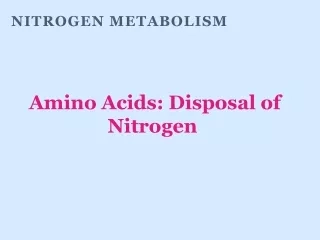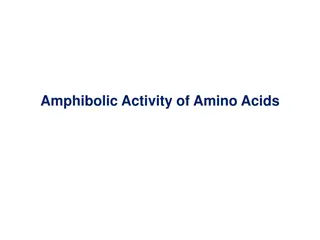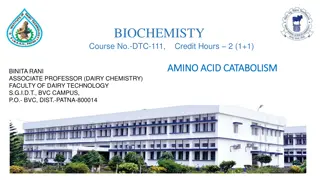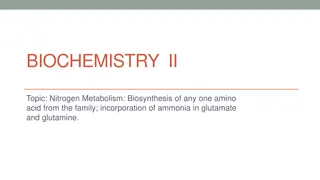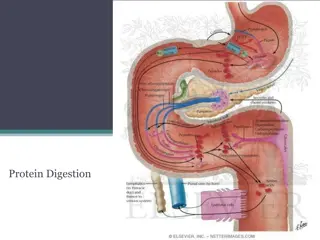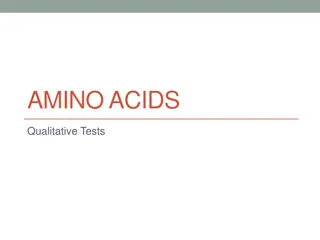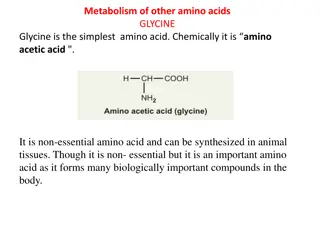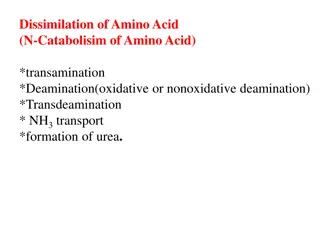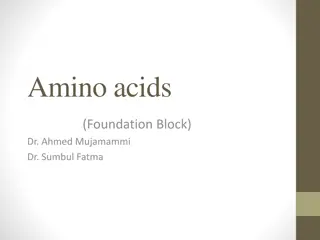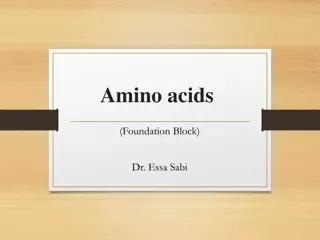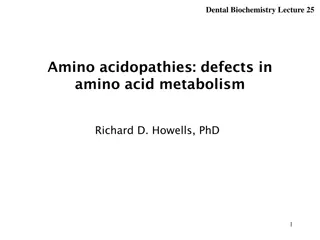Understanding Inborn Errors of Amino Acid Metabolism
Explore the world of inborn errors of amino acid metabolism through lectures by Dr. Sumbul Fatma. Discover conditions like Phenylketonuria (PKU), Maple Syrup Urine Disease, Albinism, and more, caused by enzyme deficiencies due to gene mutations. Learn about classical PKU, hyperphenylalaninemia, and the role of cofactors like Tetrahydrobiopterin (BH4). Understand the characteristics of PKU and its impact on tyrosine, melanin, catecholamines, and serotonin.
Download Presentation

Please find below an Image/Link to download the presentation.
The content on the website is provided AS IS for your information and personal use only. It may not be sold, licensed, or shared on other websites without obtaining consent from the author. Download presentation by click this link. If you encounter any issues during the download, it is possible that the publisher has removed the file from their server.
E N D
Presentation Transcript
Lecture 2: Inborn Errors of aminoacid Metabolism Dr. Sumbul Fatma
Inborn Errors of amino acid Metabolism Caused by enzyme loss or deficiency due to gene mutation Cofactors Enzyme + Substrate Product Deficient Excess
Inborn diseases of amino acid metabolism Phenylketonuria Maple syrup Urine Disease Albinism Homocystinuria Alkaptonuria
Phenylketonuria (PKU) Most common disease of aminoacid metabolism Due to deficiency of phenylalanine hydroxylase enzyme Results in hyperphenylalaninemia and tyrosine deficiency
Classical PKU Phenylalanine accumulated Phenylalanine hydroxylase The pathway of phenylalanine degradation
Other reasons for hyperphenylalanemia PKU contd.. Conversion of Phe to Tyr requires tetrahydrobiopterin (BH4) Even if phenylalanine hydroxylase level is normal The enzyme will not function without BH4 Hence Phe is accumulated Atypical hyperphenylalaninemia: Due to deficiency of dihydropteridine reductase, dihydrobiopterin synthetase enzymes
Characteristics of PKU In the absence of BH4, Phe will not be converted to Tyr No or less Tyrosine/ also inhibited by excess Phe ge Pa 10 02 No or less melanin Light skin in PKU patients Melanin Melanin biosynthesis from tyrosine: Deficiency of tyrosinase leads to albinisim
Characteristics of PKU Tyr will not be converted to catecholamines and Trp will not be converted to serotonin as they require BH4 Catecholamines and serotonin are neurotransmitters
Characteristics of PKU Elevated phenylalanine in tissues, plasma, urine Phe is degraded to phenyllactate, phenylacetate, phenylpyruvate Gives urine a mousy odor Cause of mousy urine smell in PKU
Characteristics of PKU CNS symptoms: Mental retardation, failure to walk or talk, seizures, microcephaly etc. Hypopigmentation fair hair, light skin colour and blue eyes Urine has a musty (mousey) odor
Diagnosis and treatment of PKU Prenatal diagnosis is done by detecting gene mutation in fetus Neonatal diagnosis in infants is done by measuring levels of blood phe Treatment: Life long phe-restricted diet and tyrosine supplementation
Maple Syrup Urine Disease Due to deficiency of branched chain - ketoacid dehydrogenase The enzyme decarboxylates leucine, isoleucine and valine These aminoacids accumulate in blood Symptoms: mental retardation, physical disability, metabolic acidosis, etc. Maple syrup odor of urine
Maple Syrup Urine Disease Types: Classic type: Most common, due to little or no activity of branched chain -ketoacid dehydrogenase Intermediate and intermittent forms: Higher enzyme activity, symptoms are milder Thiamine-responsive form: High doses of thiamine increases -ketoacid dehydrogenase activity
Valine, Isoleucine, Leucine and their keto acids accumulated Degradation of branched-chain amino acids: valine, isoleucine and leucine. Deficiency of branched chain a-keto acid dehydrogenase leads to MSUD.
Maple Syrup Urine Disease Treatment: Limited intake of leucine, isoleucine and valine causes no toxic effects
Albinism A disease of tyrosine metabolism Tyrosine is involved in melanin production Melanin is a pigment of hair, skin, eyes Due to tyrosinase deficiency Melanin is absent in albino patients Hair, skin, eyes appear white Vision defects, photophobia Tyrosine and DOPA accumulated Tyrosinase Melanin Melanin biosynthesis from tyrosine: Deficiency of tyrosinase leads to albinisim
Homocystinuria Due to defects in homocysteine metabolism Deficiency of cystathionine -synthase Converts homocysteine to cystathionine High plasma and urine levels of homocysteine and methionine and low levels of cysteine Homocysteine is a risk factor for atherosclerosis and heart disease Skeletal abnormalities, osteoporosis, mental retardation, displacement of eye lens
Methionine and its metabolites are accumulated Cystathione b-synthase Cysteine becomes deficient Pag 100 e 2 Methionine degradation pathway: Deficiency of cystathione b-synthase leads to homocystinuria / homocysteinemia
Treatment of Homocystinuria Oral administration of vitamins B6,B12 and folate Vitamin B6 is a cofactor of cystathionine - synthase Methionine-restricted diet
Homocystinuria Hyperhomocysteinemia is also associated with: Neural tube defect (spina bifida) Vascular disease (atherosclerosis) A risk factor of heart disease
Alkaptonuria A rare disease of tyrosine degradation Due to deficiency of homogentisic acid oxidase Tyrosine catecholamine Melanin P-Hydroxyphenylpyruvatec Homogentisic acid Homogentisic acid oxidase Fumarate TCA cycle
Characteristics of Alkaptonuria Homogentisic aciduria: elevated homogentisic acid in urine which is oxidized to dark pigment over time Arthritis Black pigmentation of cartilage, tissue Usually asymptomatic until adulthood
Treatment of alkaptonuria Restricted intake of tyrosine and phenylalanine reduces homogentisic acid and dark pigmentation
Summary Disease Enzyme Aminoacids involved 1 Phenylketonuria Phenylalanine hydroxylase Phenylalanine 2 Maple syrup urine disease -ketoacid dehydrogenase Isoleucine, leucine and valine 3 Albinism Tyrosinase Tyrosine 4 Homocystinuria Cystathionine -synthase Methionine 5 Alkaptonuria Homogentisic acid oxidase Tyrosine and phenylalanine


